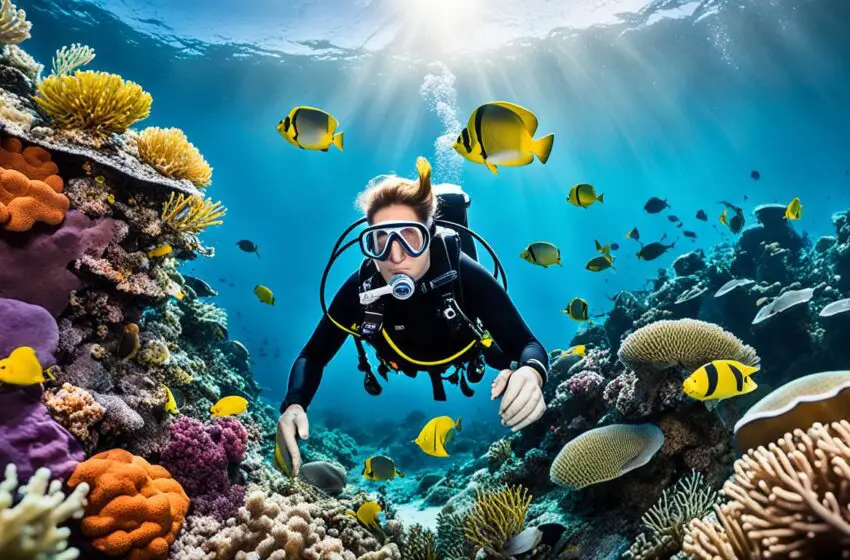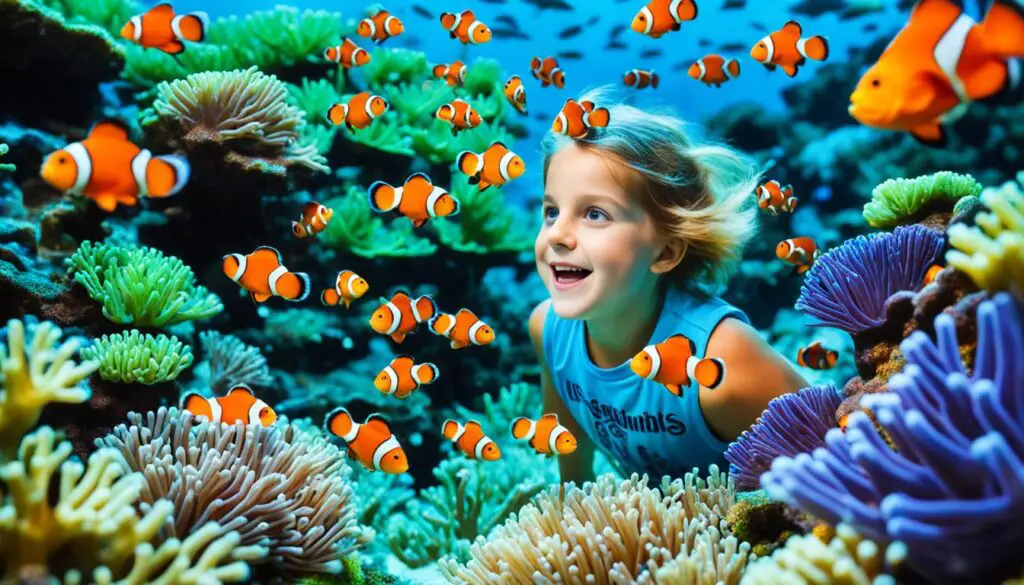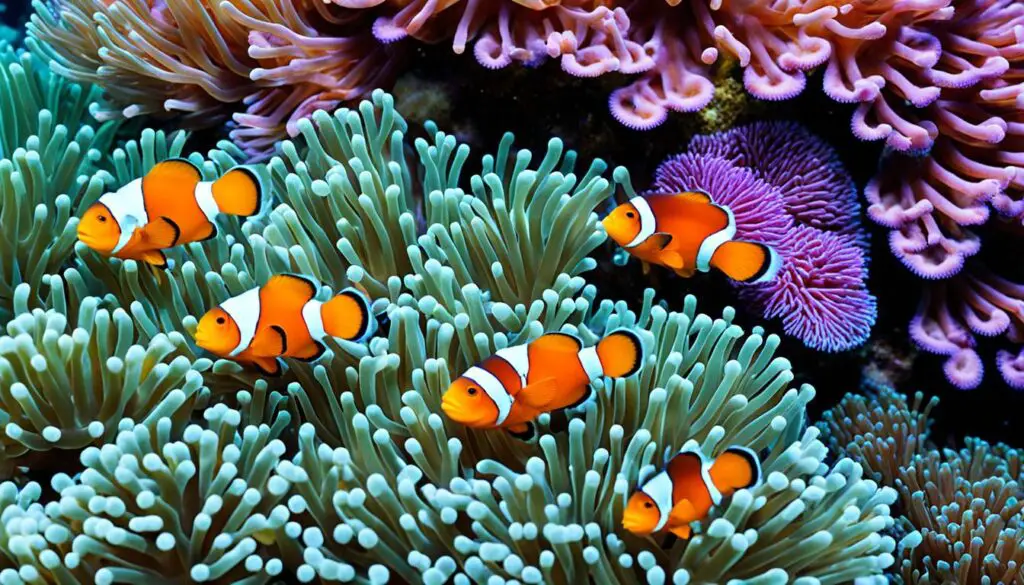Coral Reef Conservation Efforts: Creating Change: Dive into Coral Reef Conservation Efforts!

Coral reefs are very important. They offer benefits to nature and provide a home for many sea creatures. They are worth trillions to our economy and support the cultures of lots of communities.
But, these reefs are in danger because of rising sea temperatures, pollution, and other problems. A big part of them has already disappeared. Without action, they could all be gone by the end of this century.
Protecting them requires a team effort globally and locally. The NOAA Coral Reef Conservation Program leads in saving coral. They aim to reduce threats and help reefs recover by focusing on restoring habitats, saving corals, and making them more resilient.
Key Takeaways:
- Biodiversity and ecological benefits provided by coral reefs are vital for the global economy and the well-being of millions of people.
- Threats such as changing water temperatures, pollution, and invasive species are jeopardizing coral reef ecosystems.
- The NOAA Coral Reef Conservation Program leads research, conservation, and restoration efforts to protect and restore coral reefs.
- Restoration efforts focus on improving habitat quality, preventing coral loss, enhancing coral resilience, and improving coral health and survival.
- A comprehensive and collaborative approach is needed to save coral reefs and ensure their long-term survival.
Saving Coral Reefs: Strategies and Actions
Coral restoration is vital for saving and restoring coral reefs. Many methods are used to help corals bounce back and stay strong. One way is to work on making the area better for corals. This means cutting down on species that harm them or take up their space.
To keep corals safe and their homes intact, experts look for areas at risk. They jump in fast to help when trouble hits, like when a ship crashes near a reef. This quick action lessens the blow and speeds up the healing of coral life.
Getting corals to fight off dangers better is key too. Scientists are coming up with new ways to help coral babies grow up strong. These efforts are super important. They help corals deal with tough times and recover faster.
There’s also a big push to keep corals from getting sick and stop creatures from eating them. This work keeps coral families healthy. It stops diseases from spreading and predators from causing too much harm.
All these steps are crucial in the fight to saving coral reefs and ensuring their long-term survival. Bringing back healthy corals and protecting them play huge parts in keeping our oceans alive and vibrant.

Strategies and Actions for Coral Reef Conservation
| Strategy | Action |
|---|---|
| Habitat Improvement | Reducing invasive species |
| Emergency Response | Identifying high-risk areas and supporting recovery efforts |
| Coral Population Resilience | Developing innovative techniques for enhancing coral larvae survival |
| Coral Health | Controlling the spread of coral diseases and managing coral predators |
Coral Restoration Methods: From Nurseries to Outplanting
Coral restoration uses many methods to help coral populations grow and recover. One key part is creating coral nurseries. In these nurseries, corals are protected and grown. They make sure there are always healthy corals available for restoration work. The process starts by collecting corals that have broken off or are whole, and placing them in dense nurseries.
After growing in the nurseries, the corals are planted back onto reefs. This is done using materials like cement and zip ties. The team picks the spots to plant very carefully to make sure the new corals will thrive.
To help coral restoration last a long time, new and advanced growing and planting methods are being tested. It’s important to have a lot of different genetic types in the corals to help them cope with changes. This focus on different genes, not just pieces of corals, aims to make the reef corals stronger over time.
Thanks to the work done in nurseries, smart planting methods, and protecting genetic diversity, coral populations and their reef homes are steadily getting better.

Coral Restoration Methods Comparison Table
| Method | Description | Advantages | Disadvantages |
|---|---|---|---|
| Nurseries | Corals are grown in protected conditions in dense nurseries | – Provides a steady supply of healthy corals for restoration efforts | – Require space and resources – Initial investment and maintenance |
| Outplanting | Grown corals are transplanted back onto reefs using various materials | – Restores damaged reef areas – Can be tailored to habitat suitability | – Labor-intensive – Challenging survival rates |
| Genetic Diversity Conservation | Focuses on growing and planting genetically diverse coral populations | – Enhances population resilience – Increases adaptive capacity | – Requires specialized knowledge – Labor and time-intensive |
Conclusion: Working Together for Coral Reef Conservation
Conserving coral reefs is a big task that needs many groups working together. This includes government bodies, local people, research centers, and nonprofits. They all play a key part in saving and fixing coral reefs. When these groups join hands, our work in conserving coral becomes more effective. This also helps in getting more funds and resources. Working with local groups and state governments is crucial. It leads to projects that restore the beauty and health of these reefs.
It’s critical to advocate for rules based on science. Getting better policies at a national and global level is important. Such efforts mean more help and attention for coral reef conservation. New policies can set up areas that are protected, control harmful activities, and encourage eco-friendly practices.
Keeping an eye on coral reefs and checking how well our conservation projects work are vital. Scientists do this by observing the reefs up close. They figure out if our efforts are really helping these areas. This way, we can always choose the best steps and improve what we’re doing.
Building strong, lasting alliances, growing local skills, and changing policies offer us a chance to truly save coral reefs. With collective effort, we can guard these amazing ecosystems for the people of tomorrow. Let’s come together and work towards saving our planet’s coral reefs.
FAQ
What are coral reef conservation efforts?
Conserving coral reefs means protecting and rebuilding them. Actions like lessening ecosystem threats and enhancing coral’s health work towards this goal. It also involves making sure coral populations are strong and can fight off dangers.
Why are coral reefs important?
Coral reefs support many marine creatures and offer huge economic benefits. They are also critical for many people’s lives and cultures around the world.
What are the threats to coral reefs?
The threats to coral reefs are numerous, from climate change to pollution. Urgent action is needed to prevent their global die-off by the 2100s.
What is coral restoration?
Coral restoration focuses on growing and repairing coral populations. This is through methods like starting coral nurseries and re-planting them in the wild. It’s crucial for bringing back these vital ecosystems.
How do coral nurseries work?
At coral nurseries, corals are grown safely for later use in the wild. Workers collect coral fragments, grow them using special techniques, and then move them back to the ocean.
Why is genetic diversity important in coral restoration?
Genetic diversity helps coral adapt to new challenges. It’s key for their survival. Scientists are looking into ways to support a broad range of coral genetics for this reason.
Who is involved in coral reef conservation?
Coral conservation is a team effort. It involves governments, communities, scientists, and non-profits. Together, they work to protect and restore coral reefs.
What is the role of monitoring and evaluation in coral reef conservation?
Monitoring and evaluating coral reefs help scientists track their health. This allows for better conservation strategies, ensuring that actions taken are effective.
How can I contribute to coral reef conservation?
You can help by backing conservation groups and making eco-friendly choices. Also, spread the word on the importance of coral reefs. Together, these steps make a big difference.



